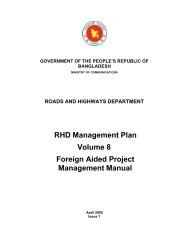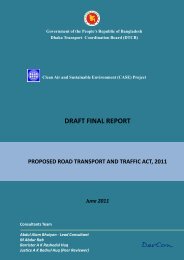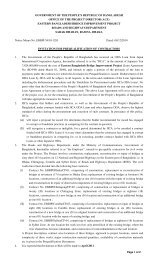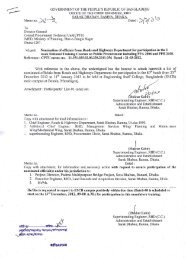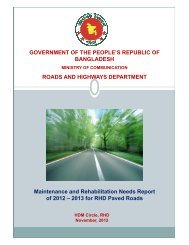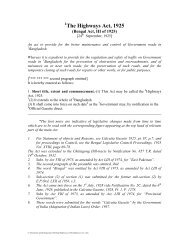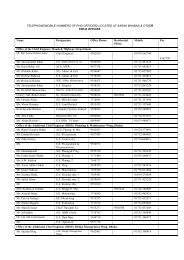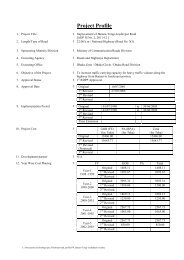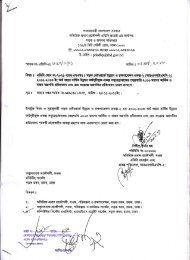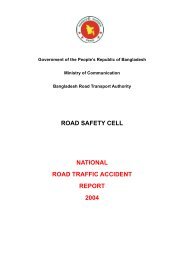Issue 2 - Roads and Highways Department
Issue 2 - Roads and Highways Department
Issue 2 - Roads and Highways Department
Create successful ePaper yourself
Turn your PDF publications into a flip-book with our unique Google optimized e-Paper software.
.<br />
RHD NEWSLETTER<br />
March 2003<br />
Volume 1, <strong>Issue</strong> 2<br />
A Quarterly on Activities of<br />
<strong>Roads</strong> <strong>and</strong> <strong>Highways</strong> <strong>Department</strong><br />
Inside this issue<br />
1<br />
1<br />
3<br />
4<br />
5<br />
7<br />
8<br />
Road Maintenance to<br />
Receive Increased Fund<br />
Project for Backlog<br />
Maintenance<br />
KFAED to Finance Three<br />
Bridges<br />
Seminar on Technology<br />
Know-how Transfer<br />
Environment <strong>and</strong> RHD<br />
New Office Building for<br />
RHD<br />
New Chief Engineer for<br />
RHD<br />
Editor:<br />
Jalaluddin Al-Quaderi<br />
Executive Engineer, RHD<br />
B-417, Sarak Bhaban, Ramna, Dhaka-1000<br />
e-mail: quaderij@rhdbangladesh.org<br />
URL:http://www.rhdbangladesh.org<br />
Road Maintenance to<br />
Receive Increased<br />
Fund<br />
Finance <strong>and</strong> Communication Ministers<br />
pledge commitment to provide<br />
additional funds for road maintenance.<br />
The commitment came from Mr. M.<br />
Saifur Rahman MP <strong>and</strong> Barrister<br />
Nazmul Huda MP while they were<br />
attending a seminar on Alternative<br />
Funding Options for Road Maintenance<br />
at the Bangladesh-China Friendship<br />
Conference Centre in Dhaka on 26<br />
January 2003. Secretary, Ministry of<br />
Communication Syed Rezaul Hayat was<br />
present in the seminar. Delegates from<br />
Ministries of Finance, Communication,<br />
Local Govt. <strong>and</strong> the Planning<br />
Commission were represented. Senior<br />
officials from the World Bank, ADB,<br />
DFID <strong>and</strong> the Danish Embassy also<br />
attended.<br />
Many billions of dollars have been<br />
invested in the road network of<br />
Bangladesh over the past 30 years <strong>and</strong><br />
roads now account for over 70 percent<br />
of both passenger <strong>and</strong> freight<br />
movements. In recent years, the rapid<br />
expansion of the network has far<br />
outstripped the nation’s ability to fund<br />
adequate maintenance. The resulting<br />
poor condition of the road network is<br />
causing economic losses to Bangladesh<br />
of nearly 500 million dollars a year, yet<br />
current annual spending on maintenance<br />
is less than 60 million dollars.<br />
The ministers heard presentations from<br />
the Chief Engineer of <strong>Roads</strong> <strong>and</strong><br />
<strong>Highways</strong> <strong>Department</strong> outlining the<br />
challenges faced by the RHD <strong>and</strong> other<br />
road agencies; <strong>and</strong> from an international<br />
expert on Road Fund Dr. Richard<br />
Robinson, on how other countries have<br />
addressed the problem of perennial<br />
under-funding. The alternative means of<br />
financing road maintenance were<br />
discussed in the seminar where the<br />
creation of a special Road Fund as an<br />
option was emphasized.<br />
It was disclosed in the seminar that the<br />
Road Fund which has proved very<br />
successful in other countries is funded<br />
Continued on Page 2<br />
Project for Backlog<br />
Maintenance<br />
RHD has submitted a Project Concept<br />
Paper (PCP) to the Planning<br />
Commission justifying money for<br />
clearing a maintenance backlog<br />
accumulated so far. According to an<br />
estimate from HDM model, the<br />
maintenance backlog amounting Taka<br />
2000 crore is being increased every year<br />
due to the scarcity of maintenance fund<br />
placed against its roads <strong>and</strong> bridges<br />
from revenue budgets.<br />
Sources say that, the RHD has an<br />
estimated assets of Tk. 44,000 crore<br />
Continued on Page 2<br />
An Effort of<br />
RHD Future Looking Junior Forum<br />
. . . . . . . . . . . . . . . . . . . . . . .
RHD Newsletter<br />
Road Maintenance<br />
RHD Current Assets (Crore Taka)<br />
1350<br />
2600<br />
7050<br />
Continued from Page 1<br />
by a charge levied on road users based<br />
on the wear <strong>and</strong> tear they impose on<br />
roads. The creation of a Road Fund is<br />
already foreseen in the GoB National<br />
Strategy for Economic Growth <strong>and</strong><br />
Poverty Reduction <strong>and</strong> the National<br />
L<strong>and</strong> Transport Policy.<br />
The Minister of Finance <strong>and</strong> Planning<br />
stated that he intended to increase the<br />
current expenditure on road<br />
maintenance <strong>and</strong> the Minister of<br />
Communication re-emphasized the<br />
commitment of his Ministry to provide<br />
timely <strong>and</strong> adequate maintenance fund.<br />
The ministers agreed that work should<br />
immediately begin to develop a<br />
sustainable means of funding road<br />
maintenance as proposed, under a<br />
specially constituted high-level Steering<br />
Committee. The seminar decided that<br />
the committee would carryout extensive<br />
public consultation with road users <strong>and</strong><br />
other stakeholders in the road sector <strong>and</strong><br />
investigate implementation<br />
arrangements most suitable for<br />
Bangladesh. Donors represented at the<br />
seminar agreed in principle to support<br />
these activities. Sources opined that the<br />
design process for the Road Fund is<br />
expected to take at least one year.<br />
Backlog<br />
Maintenance<br />
Continued from Page 1<br />
(USD 7.4 billion) comprised mostly of<br />
the value of its roads <strong>and</strong> bridges (about<br />
33000<br />
92%). The others are l<strong>and</strong> <strong>and</strong> buildings<br />
(around 6%), ferry & equipment (about<br />
Taka Crore<br />
2000<br />
1600<br />
1200<br />
800<br />
400<br />
0<br />
2000<br />
2002<br />
2%). It may be mentioned here that, the<br />
RHD has a road network of about<br />
21,000 km with approximately 10,000<br />
bridges <strong>and</strong> culverts being in the<br />
network.<br />
The RHD has estimated that Tk. 700<br />
crore per annum needs to be spent to<br />
preserve the network it manages. Of this<br />
total, Tk. 500 crore is for annual<br />
periodic & routine maintenance <strong>and</strong> an<br />
additional Tk. 200 crore to remove the<br />
backlog of maintenance works deferred<br />
from previous years. It would take at<br />
least 10 years to remove the backlog at<br />
this rate of expenditure.<br />
Against this, annual allocations for<br />
maintenance have been of the order of<br />
only Tk. 220 crore. This mainly comes<br />
from the revenue budget, though some<br />
funds allocated to the development<br />
projects have in fact been spent on<br />
maintenance work.<br />
The current volume of investment is in<br />
severe danger of being wasted unless a<br />
more rational approach to development<br />
is adopted.<br />
Experts say<br />
that<br />
increases in<br />
Bridges allocation<br />
L<strong>and</strong> from the<br />
Other Assets<br />
revenue<br />
budget are<br />
<strong>Roads</strong><br />
unlikely in<br />
the present<br />
economic<br />
Expenditure & Maintenance<br />
climate. Even if such a commitment<br />
were made, it would be subject to<br />
change from one year to the next <strong>and</strong><br />
would not address the long term needs<br />
of the road sector. The situation could<br />
be alleviated somewhat in the short to<br />
medium term if maintenance were<br />
included as a project in the Annual<br />
Development Programme. Maintenance<br />
is an investment in asset value, <strong>and</strong><br />
there is a case for bringing it –<br />
particularly the maintenance backlog —<br />
under the mantle of ADP where more<br />
control <strong>and</strong> discipline can be applied to<br />
the allocation <strong>and</strong> spending of funds.<br />
Even if the government goes for the<br />
creation of a Road Fund as a long term<br />
solution of the problem, as has been<br />
indicated in the seminar on Alternative<br />
Funding Options for Road Maintenance<br />
held in the Bangladesh-China<br />
International Conference Centre on 26<br />
January 2003, it would be necessary to<br />
clear the backlog before the introduction<br />
of the system on fee-for-use basis.<br />
Therefore, as a short term solution to<br />
halt the drain of resources <strong>and</strong> to break<br />
the unsustainable cycle of constructdeteriorate-rehabilitate,<br />
the RHD has<br />
submitted to the government this PCP<br />
on Effective Asset Management of<br />
RHD Road Network to include in the<br />
ADP as a development project. This<br />
Project of Tk. 2000 crore is expected to<br />
be approved for inclusion in the next<br />
fiscal.<br />
2 . . . . . . . . . . . . . . . . . . . . . . .<br />
2004<br />
2006<br />
A verage Backlog<br />
over 10 years<br />
2008<br />
Year<br />
2010<br />
2012<br />
2014<br />
2016<br />
Practical<br />
Implementation<br />
Optimum<br />
Expenditure<br />
Average Backlog<br />
Long Term<br />
Maintenance<br />
Present<br />
Maintenance
KFAED to Finance<br />
Three Bridges<br />
Kuwait Fund for Arab Economic<br />
Development has committed to finance<br />
the construction of three bridges of<br />
RHD. The recent visit of a high power<br />
delegation from Kuwait in December<br />
last has confirmed that KFAED would<br />
fund the construction of the third<br />
Buriganga bridge at Bashila, second<br />
Shitalakhya bridge at Demra <strong>and</strong> Teesta<br />
bridge in Kurigram. A memor<strong>and</strong>um of<br />
underst<strong>and</strong>ing is expected to be signed<br />
in this regard in the 1 st quarter of 2003.<br />
The proposed 3 rd Buriganga bridge (708<br />
meter) at Bashila would be in the link<br />
road proposed by DMDP Integrated<br />
Transport Network Study <strong>and</strong> is<br />
expected to facilitate expansion of<br />
Dhaka city on the south-western part of<br />
the Buriganga. It would also provide an<br />
alternative outlet to Dhaka-Mawa road<br />
in southern direction <strong>and</strong> to Dhaka-<br />
Aricha highway in the western<br />
direction. The 2 nd Shitalakhya bridge<br />
(1072 meter) at Demra is expected to<br />
help diverting traffic from & to northwestern<br />
<strong>and</strong> north-eastern part of the<br />
country. The 836 meter proposed Teesta<br />
bridge is located on the 31 st kilometer of<br />
Rangpur-Kurigram Highway <strong>and</strong> is<br />
expected to help expansion of l<strong>and</strong> trade<br />
with India, Nepal <strong>and</strong> Bhutan.<br />
Earlier, feasibility studies were<br />
conducted for the Muktarpur bridge, 3 rd<br />
Buriganga bridge <strong>and</strong> 2 nd Shitalakhya<br />
bridge under KFAED assistance during<br />
January 2000 to January 2001 with an<br />
expectation that KFAED would assist in<br />
the construction of these 3 bridges. But<br />
with Chinese assistance available, GoB<br />
took up the construction work of the<br />
Muktarpur bridge, <strong>and</strong> instead,<br />
requested KFAED to include in their<br />
programme the construction of Teesta<br />
bridge whose feasibility study was<br />
conducted by GoB.<br />
Project for Wider<br />
Bridges<br />
The RHD road network would soon be<br />
experiencing reconstruction work of<br />
good number of narrow bridges <strong>and</strong><br />
culverts in the western part of<br />
Bangladesh. According to sources, UK<br />
<strong>Department</strong> for International<br />
Development (DFID) has agreed to fund<br />
this Bridge Replacement Project (BRP)<br />
to reconstruct 36 small-to-medium span<br />
bridges located on national <strong>and</strong> regional<br />
highways in Rangpur, Rajshahi &<br />
Barisal Zones of RHD. A memor<strong>and</strong>um<br />
of underst<strong>and</strong>ing was signed between<br />
GoB <strong>and</strong> DFID in this regard.<br />
The pre-construction phase of the<br />
project is on its way of completion <strong>and</strong><br />
mobilization will be started soon. This<br />
563 million Taka project is scheduled<br />
for completion by mid 2005.<br />
Though it was originally conceived as a<br />
component of IDA funded RRM-3<br />
project, due to its individuality as a<br />
bridge project <strong>and</strong> involvement of UK<br />
government with RHD bridges, DFID<br />
eventually took up the project. In late<br />
’80s <strong>and</strong> early ’90s Overseas<br />
Development Administration of UK<br />
was involved in the construction of 25<br />
bridges under ODA Bridging Project<br />
<strong>and</strong> in the improvement & maintenance<br />
of several bridges under BIM Projects.<br />
One of the unique features of this<br />
project is that, apart from construction<br />
of bridges the project aims at<br />
strengthening the capability of RHD in<br />
March 2003<br />
procurement of services from private<br />
sector for design, construction <strong>and</strong><br />
maintenance of bridges including the<br />
production of st<strong>and</strong>ardized procedure<br />
<strong>and</strong> documentation. This project is<br />
expected to address traffic congestion<br />
<strong>and</strong> road safety on the national <strong>and</strong><br />
regional highways of the western part of<br />
the country.<br />
Grouting for<br />
Increased Bearing<br />
Capacity of Pile<br />
Settlement of pile under load has<br />
always been a major challenge for<br />
engineers in bridge construction. An<br />
unusual settlement of a test pile was<br />
experienced during a pile-loading test<br />
in the Rupsa Bridge Project.<br />
It all began, when the test pile no.2<br />
beside the pier of the main bridge<br />
recorded unusual penetration,<br />
disproving consultant’s estimates used<br />
for design consideration. Consequently,<br />
the loading was suspended <strong>and</strong> the<br />
causes were investigated. Both Bureau<br />
of Research, Testing <strong>and</strong> Consultation<br />
of BUET <strong>and</strong> foreign experts were<br />
engaged to find a solution to the<br />
problem. As a countermeasure, the use<br />
of skin grout around the pile-shaft <strong>and</strong><br />
toe grout below the pile-tip showed a<br />
significant improvement in the load<br />
bearing capacity of the pile. The<br />
occurrence of unusual settlement<br />
impeded the progress of the work. The<br />
use of grout is a very costly measure<br />
<strong>and</strong> would definitely increase the cost<br />
of construction. Whether any other<br />
measure suitable to prevent the unusual<br />
settlement is available could not be<br />
known immediately.<br />
This Japan assisted Rupsa Bridge<br />
Construction Project is being<br />
constructed by Japanese contractor <strong>and</strong><br />
consultants, <strong>and</strong> is scheduled to be<br />
completed in December 2004.<br />
. . . . . . . . . . . . . . . . . . . . . . . . 3
RHD Newsletter<br />
Seminar on Technical<br />
Know-how Transfer<br />
Modern technological know-how <strong>and</strong><br />
developed management methods can<br />
help engineers in building better road<br />
infrastructure. This was reiterated by the<br />
hon’able Minister for Communication<br />
Barister Nazmul Huda, MP while he<br />
was inaugurating a seminar on<br />
Construction Industry Know-how<br />
Transfer on 18 Feb 2003. Jointly<br />
organised by the Ministry of<br />
Communication, Bangladesh <strong>and</strong><br />
Ministry of L<strong>and</strong>, Infrastructure <strong>and</strong><br />
Transport of Japan, the seminar was<br />
also attended by the Secretary, MoC<br />
Syed Rezaul Hayat, the Minister of<br />
Embassy of Japan in Bangladesh Mr.<br />
Tetsuo Yamashita <strong>and</strong> the Chief<br />
Engineer, RHD Mr. Sk. Rabiul Islam.<br />
Highlighting Japan’s contribution as a<br />
development partner of Bangladesh the<br />
hon’ble minister highly praised Japan’s<br />
effort in disseminating modern<br />
technological developments to<br />
Bangladesh <strong>and</strong> sought further<br />
cooperation from Japan particularly in<br />
road infrastructure development.<br />
In total 7 papers – 4 by Japanese experts<br />
<strong>and</strong> 3 by Bangladeshi experts -- were<br />
presented in the day-long seminar which<br />
was represented by the engineers from<br />
RHD, LGED, <strong>and</strong> different consulting<br />
firms of the country. Holding of this<br />
type of seminar on know-how transfer<br />
was initiated by Japan in 1995 <strong>and</strong> since<br />
then it has been going round the<br />
countries in Asia, East Europe, Latin<br />
America <strong>and</strong> Africa every year by turn.<br />
Seminars held in<br />
RHD<br />
A seminar to appraise the KFAED<br />
mission on financing the<br />
construction of three bridges was<br />
held on 12 December 2002.<br />
Additional Chief Engr., Technical<br />
Services Mr. Abed Uddin Ahmed<br />
presented the salient features of the<br />
3rd Buriganga, 2 nd Shitalakhya &<br />
Teesta bridge. The Chief Engineer,<br />
Mr. Fazlul Haque also addressed the<br />
session which was attended by the<br />
delegates from KFAED <strong>and</strong> senior<br />
officers from RHD.<br />
A brief appraisal session for the<br />
visiting DFID team was held in<br />
HDM seminar room on 27 January<br />
2003. The session mainly focused<br />
on the institutional development<br />
activities in RHD covering HDM,<br />
Financial Management System,<br />
Computer Networking & database<br />
Technology Transfer<br />
Centre Established<br />
PIARC Technology Transfer<br />
Centre--Bangladesh has recently<br />
been established in the IEB<br />
premises. Situated in the 1 st floor of<br />
IEB auditorium building this Centre<br />
was formally opened on 3 February<br />
2003 by the Chief Engr., RHD Mr.<br />
Md. Fazlul Haque--the First<br />
Delegate of PIARC in Bangladesh.<br />
The function was also attended by<br />
the President IEB Engr. Qumrul<br />
Islam Siddique PEng, the ICE<br />
Representative in Bangladesh Mr. I<br />
A Khan, Programme Director IDC<br />
Mr. Bill Hodgkinson, <strong>and</strong> TTC<br />
Manager Mr. Mohammed Abdul<br />
Quadir amongst others.<br />
Since it was founded in 1909, the<br />
World Road Association (PIARC)<br />
<strong>and</strong> MIS. Mr. Jalaluddin Al-Quaderi,<br />
Executive Engineer, HDM, Mr. Bill<br />
Hodgkinson, Program Director IDC<br />
<strong>and</strong> Mr. Muslim Choudhury, Financial<br />
Specialist of IDC presented papers in<br />
the session which was attended by<br />
senior RHD officials, IDC consultants<br />
<strong>and</strong> representatives from DFID.<br />
A seminar on cost effective pavement<br />
was held in HDM Circle on 23<br />
February 2003. The seminar was<br />
organized by the RHD Engineers'<br />
Association <strong>and</strong> Mr. Shafiqul Alam an<br />
Assistant Engineer of the <strong>Department</strong><br />
presented the keynote paper. In the<br />
seminar he recommended for road<br />
base a cheaper but robust combination<br />
of materials which was revealed<br />
during his research works for the<br />
fulfillment of M Phil degree under the<br />
University of Birmingham. Presided<br />
over by the President of the Samity<br />
Engr. Md. Afzal Hossain, the seminar<br />
was also attended by the Chief<br />
Engineer Mr. Sk. Rabiul Islam.<br />
has led the world as a unique<br />
international forum in the road <strong>and</strong><br />
transport sector. PIARC has been<br />
contributing to the enhancement of a<br />
better global road community<br />
through the establishment of TTCs<br />
in developing countries &<br />
economies in transition<br />
(DCs/EITs). TTC in Bangladesh<br />
is an outcome of similar efforts by<br />
PIARC <strong>and</strong> is expected to<br />
coordinate internationally with<br />
DCs/EITs <strong>and</strong> internally between<br />
stakeholders to enhance the<br />
dissemination of road related<br />
technical information.<br />
4 . . . . . . . . . . . . . . . . . . . . . . .
Environment <strong>and</strong><br />
RHD<br />
The RHD is now enforcing the<br />
implementation of environmental<br />
criteria for every road project conceived<br />
to meet the requirement of <strong>Department</strong><br />
of Environment <strong>and</strong> to ensure an<br />
improvement in the overall quality of<br />
life for the people of Bangladesh.<br />
This is being done through initial<br />
environmental evaluation – IEEE<br />
<strong>and</strong> environmental impact<br />
assessment – EIA. Recently the<br />
IDC3 consultants have prepared<br />
draft guidelines. The guidance has<br />
been developed in close<br />
consultation with other<br />
government departments, notably<br />
DoE <strong>and</strong> the major development<br />
agencies including the World<br />
Bank, the Asian Development<br />
Bank <strong>and</strong> the <strong>Department</strong> for<br />
International Development of UK.<br />
It is considered that the draft<br />
guidelines prepared are<br />
compatible with the requirements<br />
of these organizations for<br />
environmental assessment <strong>and</strong><br />
management. While preparing the<br />
guidelines, note has also been taken of<br />
the existing guidance <strong>and</strong> h<strong>and</strong>books<br />
that have been prepared by other<br />
organizations concerned with the road<br />
sector in Bangladesh e.g., LGED,<br />
CARE Bangladesh, DCC & WDB.<br />
Donor agencies like the WB <strong>and</strong> the<br />
ADB have been enforcing<br />
environmental criteria in their projects<br />
<strong>and</strong> were pursuing this issue for<br />
immediate implementation in other<br />
projects. The GoB well aware of the<br />
potential adverse consequences of road<br />
construction recognized the need to<br />
develop roads <strong>and</strong> highways in a<br />
sustainable manner.<br />
That a wide range of activities of the<br />
RHD has potential to cause<br />
environmental harm has led to the<br />
formulation of environmental guidelines<br />
for the RHD. The activities of RHD that<br />
pose potential threat to the environment<br />
encompass every sphere of a road life<br />
cycle <strong>and</strong> include planning <strong>and</strong> design<br />
(i.e., pre-construction) phase,<br />
construction phase, <strong>and</strong> operation &<br />
maintenance phase. Main threatening<br />
activities in the pre-construction phase<br />
are: choice of road alignment, bridge or<br />
ferry-ghat location through an<br />
environmentally sensitive area,<br />
uncertainty of local people over l<strong>and</strong><br />
acquisition, <strong>and</strong> embankments affecting<br />
water flow & navigation. In the<br />
construction phase, major<br />
environmental threats come from loss of<br />
roadside trees, air pollution from brick<br />
fields & hot-mix plants, erosion &<br />
sedimentation from embankments <strong>and</strong><br />
cuttings, <strong>and</strong> delays to traffic during<br />
construction. In the operation &<br />
maintenance phase, the threats come<br />
from air pollution due to the exhausts<br />
from the motorized transports, <strong>and</strong><br />
traffic noise. According to the<br />
guidelines, there is a range of<br />
mechanisms or techniques used to<br />
manage environmental impacts <strong>and</strong><br />
these can be used as appropriate to<br />
cover all of the activities of RHD.<br />
March 2003<br />
The approach that is taken to minimize<br />
adverse impacts is called mitigation <strong>and</strong><br />
the way this is done is through the<br />
application of mitigation measures.<br />
There are number of ways in which<br />
mitigation measures can reduce the<br />
negative impact of a project. These<br />
range from fundamental design or route<br />
change through to<br />
compensation of affected<br />
persons. But in all instances,<br />
there is a preferred order or<br />
hierarchy for addressing the<br />
potentially negative impacts<br />
e.g., firstly, in the form of<br />
avoidance or prevention<br />
(say, cancellation of a<br />
scheme or project, or<br />
changes in the design or<br />
construction method), if that<br />
is not possible then,<br />
minimization <strong>and</strong>/or<br />
alleviation (say, planting of<br />
trees or safety barriers), <strong>and</strong><br />
lastly, enhancement (say,<br />
introduction of pedestrian<br />
refuge in the middle of the<br />
road passing through the<br />
village, as the case may be). The draft<br />
National L<strong>and</strong> Transport policy of 2002<br />
sets out the strategic policy framework<br />
for the activities of RHD. It identifies<br />
the need for Bangladesh to develop a<br />
sustainable environment <strong>and</strong><br />
acknowledges the environmental<br />
disadvantages of road development.<br />
Good environmental management can<br />
help to avoid or significantly reduce<br />
adverse impacts of road infrastructure<br />
development. The concept of<br />
environmental management recognizes<br />
that human actions damage the<br />
environment but seeks mechanisms to<br />
manage or control these negative<br />
impacts within acceptable or sustainable<br />
limits.<br />
. . . . . . . . . . . . . . . . . . . . . . . . 5
RHD Newsletter<br />
Four Return having Completed Masters Overseas<br />
Four Assistant Engineers of the <strong>Department</strong> have recently returned from overseas. Mr. Shafiqul Alam, Mr. Mahbubl Alam,<br />
<strong>and</strong> Mr. Syed Moinul Hasan all went to the UK <strong>and</strong> Mr. Md. Nazmus Sadat went to Australia. All four went for higher level<br />
studies, paid for by direct DFID assistance facilitated by the British Council <strong>and</strong> planned & programmed by IDC-3. The<br />
following texts are extracts from the dissertation of 3 of these 4 returned engineers.<br />
Cheaper materials for road<br />
base suggested:<br />
Use of cement stabilised brick<br />
aggregate-s<strong>and</strong>-soil mix as road<br />
base material gives satisfactory<br />
results in pavement construction.<br />
This was revealed by Mr. Md.<br />
Shafiqul Alam, Assistant Engineer,<br />
Road Research Laboratory during<br />
his research work as a part of<br />
fulfilment of M Phil degree in the<br />
University of Birmingham recently.<br />
He believes that, being a cheaper<br />
<strong>and</strong> stronger technique the<br />
implementation of his findings<br />
could start a new phase in<br />
pavement construction.<br />
The research suggests that, in<br />
contrast to current practice of using<br />
mixes of low grade brick aggregate<br />
<strong>and</strong> fine s<strong>and</strong>, an addition of some<br />
amount of soil <strong>and</strong> small<br />
percentage of cement would give<br />
substantial strength in the road base<br />
in terms of CBR value. The<br />
presence of montmorillonite<br />
mineral in the locally available clay<br />
contributes towards that strength.<br />
An assessment by the researcher<br />
indicated that the newly proposed<br />
mix is cheaper than RHD st<strong>and</strong>ard<br />
stone-aggregate road base mix.<br />
In another finding during his<br />
research work, Mr. Shafiq opined<br />
that an open graded drainage layer<br />
between the surface <strong>and</strong> road base<br />
facilitates faster drainage of surface<br />
intrusions thereby helping<br />
serviceability <strong>and</strong> longevity of the<br />
road pavement. Most of the<br />
pavements in Bangladesh are made<br />
of weak brick aggregates that<br />
deteriorate rapidly due to trapped<br />
moisture not finding adequate<br />
drainage. He argued that this<br />
intermediate drainage layer would<br />
help draining out the entrapped<br />
water through the edges of the<br />
road.<br />
Road Deterioration Model<br />
Calibrated:<br />
The Road Deterioration model of<br />
HDM-4 has been calibrated to meet<br />
the local Bangladeshi condition <strong>and</strong><br />
environment. The series of studies<br />
required for this purpose were<br />
conducted by Mr. Mahbubul Alam<br />
Khan, Assistant Engineer, Road<br />
Research Laboratory during his M<br />
Phil course in the University of<br />
Birmingham. It is expected that his<br />
findings would help the HDM model<br />
to predict the performance of<br />
pavement with increased degree of<br />
reliability that is essential to determine<br />
representative life cycle of the<br />
pavement in Bangladesh. The findings<br />
of Mr. Mahbub have also been<br />
validated for existing climate <strong>and</strong><br />
traffic conditions of Bangladesh. The<br />
HDM model in Bangladesh is now<br />
using the road deterioration values as<br />
suggested by the consultants on the<br />
basis of their experience. Mr. Mahbub<br />
has been posted to HDM circle after<br />
his return from Birmingham.<br />
The 4th version of the Highway<br />
Development <strong>and</strong> Management<br />
(HDM4) model has essentially two<br />
sub-models: Road Deterioration<br />
Work-effects model <strong>and</strong> Road User<br />
Effects model. Mr. Mahbub calibrated<br />
RDWE model considering the<br />
common types of road defects of<br />
Bangladesh such as cracking,<br />
ravelling, potholing, edge-breaking,<br />
rutting <strong>and</strong> roughness progression. He<br />
finds out different sets of calibration<br />
factors for Asphalt mix on Granular<br />
Base <strong>and</strong> Surface treatment on<br />
Granular Base types pavement <strong>and</strong><br />
also suggests two sets of calibration<br />
adjustment factors for them<br />
separately. These maintenance<br />
treatments e.g., manual seal, surface<br />
treatment <strong>and</strong> overlay have also been<br />
calibrated by the researcher to<br />
accurately reflect the after workeffects<br />
of the treatment.<br />
Real-Time Communication:<br />
Switched Ethernet Networks can<br />
also be used for real time<br />
communications. This was the<br />
outcome of the thesis of Mr. Syed<br />
Moinul Hasan, Asstt. Engr., HDM<br />
circle. He has recently completed M<br />
Sc. on IT Networking Systems from<br />
the University of Derby.<br />
Over the past few years there has<br />
been growing interest among IT<br />
users to integrate voice, video <strong>and</strong><br />
data over communication networks.<br />
Voice <strong>and</strong> video data in particular,<br />
are distinguished from other data<br />
(e.g., email, text files) because of<br />
their time constrained nature. These<br />
are to be delivered to the receiver<br />
end within a time interval else they<br />
become useless. When words arrive<br />
delay at either end during a<br />
telephonic conversation the necessity<br />
of real time communication can be<br />
realized. So audio <strong>and</strong> video data<br />
require real-time communication.<br />
RHD uses Switched Ethernet<br />
technology in its local area network.<br />
Though technically it was not<br />
suitable for time constrained<br />
communication recent advancements<br />
in Switched Ethernet technology<br />
now allow users to communicate in a<br />
real time environment. As audio <strong>and</strong><br />
video data are given priority over<br />
other data so they are treated<br />
specially by the Switch in an<br />
Ethernet network.<br />
Mr. Moinul's work may play an<br />
important role in implementing voice<br />
mail in RHD. Moreover, video<br />
conferencing could be done in future<br />
between RHD HQ <strong>and</strong> field offices<br />
if the access layer technology is<br />
equipped with Switched Ethernet.<br />
Even GIS applications might become<br />
easily downloadable using this<br />
enhanced implementation outline.<br />
6 . . . . . . . . . . . . . . . . . . . . . . .
Using MIS in RHD<br />
User participation in the evaluation of<br />
information system of RHD has become<br />
the main concern. That the process of<br />
developing a system should include its<br />
analysis <strong>and</strong> underst<strong>and</strong>ing users<br />
requirement was missing. Capturing<br />
users requirement <strong>and</strong> then building the<br />
system & testing its performance with<br />
its users can be defined as evaluation.<br />
No doubt, Management Information<br />
Systems (MIS) are aimed at assisting in<br />
decision making. They provide<br />
accurate, reliable <strong>and</strong> valid information<br />
whenever such information is needed.<br />
In recent years RHD has been able to<br />
develop its own MIS under the guidance<br />
of IDC 3 consultants. Although a<br />
complete MIS is in the process of being<br />
made, some useful information can be<br />
extracted from those systems already<br />
developed.<br />
Now it is the time for RHD to evaluate<br />
the developed MIS. One might ask what<br />
can s/he do as a user? Interestingly, it is<br />
the responsibility of the end user to help<br />
the system developers make a usable<br />
system. Users have to play an important<br />
role in shaping their own information<br />
system. For example, one may want to<br />
know the current place of posting of his<br />
colleague. Or an administrator might be<br />
interested to get the list of officers<br />
posted to a place for more than three<br />
years. To that end one might consult the<br />
telephone directory or might ask a<br />
friend or check with the administration.<br />
But a common problem with all these<br />
efforts is the fear of wrong information.<br />
In contrast, MIS can offer users a<br />
reliable information service. The MIS<br />
developed in the RHD can provide with<br />
this kind of information quite rapidly<br />
<strong>and</strong> accurately. The user has to state<br />
clearly what s/he wants as an output. So<br />
the interaction between the user <strong>and</strong> the<br />
system is important.<br />
MIS in RHD has the potential to<br />
provide information on personnel,<br />
organization, publications <strong>and</strong> floated<br />
tenders. Moreover, databases on road<br />
<strong>and</strong> bridge maintenance are the other<br />
two important parts of RHDMIS. Its<br />
features can be used for general purpose<br />
works <strong>and</strong> special purpose works. Both<br />
Intranet <strong>and</strong> Internet versions of MIS<br />
databases are now in use. As a general<br />
purpose, a user accessing RHD web<br />
server, URL://www.rhdbangladesh.org<br />
over the Internet with any web browser<br />
(e.g., Internet Explorer or NetScape<br />
Navigator) can view the Internet version<br />
of the databases. Personnel <strong>and</strong><br />
organization databases are updated<br />
regularly <strong>and</strong> so the information<br />
extracted from these are recent <strong>and</strong><br />
reliable. Tender database also provides<br />
information on recent tenders. RMMS<br />
has always been an integral part for the<br />
operation of HDM (Highway<br />
Development <strong>and</strong> Management) model.<br />
Although RHD developed this special<br />
purpose Road Maintenance<br />
Management System, with the help of<br />
RHDMIS the RMMS can now provide<br />
road network information to a wider<br />
audience. In the near future GIS maps<br />
will be dynamic in nature i.e., RMMS<br />
<strong>and</strong> GIS will be inter-linked, <strong>and</strong> any<br />
update in RMMS will be reflected in<br />
GIS maps.<br />
Currently IDC3 consultants are<br />
managing the RHDMIS activities, but<br />
RHD shall have to take over its charge.<br />
Now having a new MIS circle in place,<br />
the RHD has to plan <strong>and</strong> organize<br />
personnel <strong>and</strong> functions of MIS circle<br />
such that it plays the pioneering role for<br />
the sustainability of information<br />
systems in RHD. Participation of both<br />
developers <strong>and</strong> users of the systems,<br />
however, needs to be ensured.<br />
New RHD Building<br />
March 2003<br />
A new office building in the<br />
headquarters premises of RHD is<br />
going to be constructed very soon.<br />
The hon’ble Minister for<br />
Communication Barister Nazmul<br />
Huda, MP unveiled the plaque of<br />
the memor<strong>and</strong>um ceremoniously on<br />
3 February 2003 at the Sarak<br />
Bhaban. The function was attended<br />
by the hon’ble State Minister of<br />
Communication Mr. Salahuddin<br />
Ahmed, MP, Secretary Ministry of<br />
Communication Syed Rezaul Hayat<br />
<strong>and</strong> the Chief Engineer of RHD Mr.<br />
Md. Fazlul Haque amongst others.<br />
Shortage of office space in<br />
headquarter buildings of RHD is<br />
long being felt. This has<br />
significantly been increased due to<br />
concentration of planning posts<br />
back to headquarters through recent<br />
reorganisation processes. Moreover<br />
bigger projects supported by the<br />
World Bank <strong>and</strong> the Asian<br />
Development Bank ask from the<br />
RHD for the provision of the office<br />
space for their consultants. Hence<br />
the construction of the D Block was<br />
planned anticipating contribution<br />
from different foreign aided<br />
projects. Accordingly, the Road<br />
Maintenance <strong>and</strong> Improvement<br />
Project financed by ADB is going to<br />
construct the first half of the<br />
proposed eight-storied building with<br />
floors for car parking facilities. The<br />
original Sarak Bhaban had only two<br />
blocks <strong>and</strong> was opened for use in<br />
1979, <strong>and</strong> later Block C was added<br />
to it in 1998-2002 period.<br />
. . . . . . . . . . . . . . . . . . . . . . . . 7
RHD Newsletter<br />
New Chief Engineer<br />
for RHD<br />
Mr. Sk. Rabiul Islam takes over as the<br />
Chief Engineer of the <strong>Roads</strong> <strong>and</strong><br />
<strong>Highways</strong> <strong>Department</strong> on 4 February<br />
2003. He replaced Mr. Md. Fazlul<br />
Haque who went to retirement on the<br />
same day.<br />
After graduated from Rajshahi<br />
Engineering College, Sk. Rabiul Islam<br />
joined the <strong>Department</strong> on 14 October<br />
1969 as an Assistant Engineer.<br />
Throughout most of his service life, he<br />
served in the planning <strong>and</strong> design units<br />
of the <strong>Department</strong> <strong>and</strong> established<br />
himself as a reputed bridge designer. He<br />
became the Additional Chief Engineer<br />
in 2000 <strong>and</strong> served in the Khulna zone<br />
<strong>and</strong> in the network management unit of<br />
RHD. Prior to his joining as the Chief<br />
Engineer of RHD, he was the Chief<br />
Engineer of Jamuna Multi-purpose<br />
Bridge Authority since May 2002.<br />
Mr. Sk. Rabiul Islam sought<br />
cooperation from everybody of the<br />
<strong>Department</strong> while he was speaking in a<br />
reception organized by the<br />
administration <strong>and</strong> attended by all<br />
sections of officers <strong>and</strong> employees of<br />
the <strong>Department</strong>. The function also<br />
accorded reception to the newly<br />
appointed Chief Engineer of JMBA Mr.<br />
Muhammad Shjahan <strong>and</strong> farewell to the<br />
outgoing Chief Engineer of RHD Mr.<br />
Md. Fazlul Haque. Held in the Seminar<br />
room in Block C of Sarak Bhaban, the<br />
function was also attended by the<br />
hon'ble State Minister for<br />
Communication, Mr. Salahuddin<br />
Ahmed MP <strong>and</strong> the Secretary of MoC<br />
Syed Rezaul Hayat.<br />
Four RHD Engineers<br />
Conferred PEng.<br />
Mr. Khonakar Azadur Rahman <strong>and</strong> Mr.<br />
Adam Ali Ghazi, the Additional Chief<br />
Engineers of <strong>Roads</strong> <strong>and</strong> <strong>Highways</strong><br />
<strong>Department</strong> have recently been<br />
conferred the degree of Professional<br />
Engineering, PEng as they achieved the<br />
st<strong>and</strong>ards established by Bangladesh<br />
Professional Engineers Registration<br />
Board (BPERB). They join the list of<br />
two others of RHD who received the<br />
PEng degree earlier in the very first<br />
batch. They are Engr. Zia Hasan Ibn<br />
Ahamed, SDE, Workshop Sub-<br />
Division, Dhaka <strong>and</strong> Engr. Md. Maasud<br />
Ali, Senior Assistant Director (Mech),<br />
RHDTC.<br />
The BPERB was established in 2001 to<br />
develop the engineering profession in<br />
Bangladesh <strong>and</strong> to establish <strong>and</strong><br />
maintain a high st<strong>and</strong>ard of professional<br />
competence within the engineering<br />
profession. The board establishes the<br />
st<strong>and</strong>ards to be achieved by engineers<br />
wishing to be registered as Professional<br />
Engineers <strong>and</strong> assesses applicants for<br />
registration against these st<strong>and</strong>ards,<br />
through rigorous oral <strong>and</strong> written<br />
examinations.<br />
RHD officers<br />
Appointed as DS<br />
Three officers of RHD have been<br />
appointed as Deputy Secretaries to the<br />
government <strong>and</strong> have been posted to the<br />
Ministry of Establishment as officers on<br />
special duty. The officers are Mr. Tajul<br />
Islam Chowdhury, Project Manager,<br />
Road Maintenance <strong>and</strong> Improvement<br />
Project, Chittagong, Mr. Jalaluddin Al-<br />
Quaderi, Executive Engineer, HDM<br />
Operation Division, Dhaka, <strong>and</strong> Mr.<br />
Mohammad Abdul Quadir, Sub-<br />
Divisional Engineer, Routine<br />
Maintenance Sub-division, Dhaka. They<br />
form a part of 493 officers who have<br />
been promoted as DS on 10 February<br />
2003.<br />
Though provisions were there, it is after<br />
a long gap that officers from BCS<br />
(<strong>Roads</strong> & <strong>Highways</strong>) cadre are joining<br />
as DS. Earlier Mr. Atiur Rahman, an<br />
Executive Engineer of RHD availed this<br />
opportunity in early ‘80s. It may be<br />
mentioned here that, officers having 10<br />
years’ service in the cadre with 5years’<br />
experience as SDE are eligible to apply<br />
for the option.<br />
RHD Library<br />
Relocated<br />
The Library in the headquarters of<br />
RHD has been relocated to 1 st floor<br />
of Block C in the Sarak Bhaban.<br />
The newly decorated space for the<br />
Library was formally opened for use<br />
through an unostentatious ceremony<br />
on 3 February 2003 by the Chief<br />
Engineer Mr. Md. Fazlul Haque.<br />
The RHD Library was first<br />
established in mid '80s in the ground<br />
floor of Block A, but was later<br />
shifted to Block B in the premises.<br />
RHD Library has a collection of<br />
more than 5400 books apart from<br />
nearly 4500 Study Reports <strong>and</strong> 1200<br />
technical journals & periodicals<br />
under the supervision of an<br />
Assistant Librarian <strong>and</strong> a cataloguer.<br />
Facilities like internet <strong>and</strong> intranet<br />
browsing including email are<br />
expected to be established in the<br />
library very soon.<br />
8 . . . . . . . . . . . . . . . . . . . . . . .



